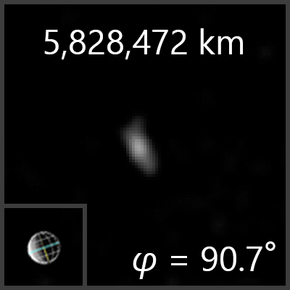 Low-resolution image of Elara from the New Horizons probe, March 2007 | |
| Discovery [1][2] | |
|---|---|
| Discovered by | Charles D. Perrine |
| Discovery site | Lick Observatory |
| Discovery date | 5 January 1905 |
| Designations | |
Designation | Jupiter VII |
| Pronunciation | /ˈɛlərə/[3] |
Named after | Ελάρα Elăra[4] |
| Adjectives | Elarian /ɛˈlɛəriən/ |
| Orbital characteristics [5] | |
| Epoch 27 April 2019 (JD 2458600.5) | |
| Observation arc | 113.70 yr (41,528 days) |
| 0.0782306 AU (11,703,130 km) | |
| Eccentricity | 0.1961487 |
| +258.65 d | |
| 10.93078° | |
| 1° 23m 30.67s / day | |
| Inclination | 30.51712° (to ecliptic) |
| 90.86474° | |
| 191.19922° | |
| Satellite of | Jupiter |
| Group | Himalia group |
| Physical characteristics | |
| 79.9±1.7 km[6] | |
| Albedo | 0.046±0.007[6] |
| 16.6[7] | |
| 9.6[5] | |
Elara /ˈɛlərə/ is a prograde irregular satellite of Jupiter. It was discovered by Charles Dillon Perrine at Lick Observatory in 1905 in photographs taken with the 36" Crossley reflecting telescope which he had recently rebuilt.[1][8] It is the eighth-largest moon of Jupiter and is named after Elara, one of Zeus's lovers and the mother of the giant Tityos.[9]
Elara did not receive its present name until 1975; before then, it was simply known as Jupiter VII. It was sometimes called "Hera"[10] between 1955 and 1975. It has a mean radius of just 43 kilometres (27 mi), thus it is 2% of the size of Europa. However, it is half the size of Himalia, so it is the second-biggest moon in the Himalia group. It might be a captured type C or D asteroid, for it reflects very little light.
Elara belongs to the Himalia group, moons orbiting between 11 and 13 gigametres from Jupiter at an inclination of about 27.5°.[11] Its orbital elements are as of January 2000. They are continuously changing due to solar and planetary perturbations.
- ^ a b Cite error: The named reference
Harvard1905was invoked but never defined (see the help page). - ^ Cite error: The named reference
Perrine1905was invoked but never defined (see the help page). - ^ James Knowles (1851) A Critical Pronouncing Dictionary of the English Language
- ^ DGE en línea
- ^ a b Cite error: The named reference
MPC115889was invoked but never defined (see the help page). - ^ a b Cite error: The named reference
Grav2015was invoked but never defined (see the help page). - ^ Cite error: The named reference
SheppardMoonswas invoked but never defined (see the help page). - ^ Cite error: The named reference
Perrine 1905was invoked but never defined (see the help page). - ^ Marsden, Brian G. (7 October 1975). "Satellites of Jupiter". International Astronomical Union. Archived from the original on 22 February 2014.
- ^ Payne-Gaposchkin, Cecilia; Katherine Haramundanis (1970). Introduction to Astronomy. Englewood Cliffs, N.J.: Prentice-Hall. ISBN 0-13-478107-4.
- ^ Jacobson, R. A. (2000). "The orbits of outer Jovian satellites" (PDF). Astronomical Journal. 120 (5): 2679–2686. Bibcode:2000AJ....120.2679J. doi:10.1086/316817. S2CID 120372170.